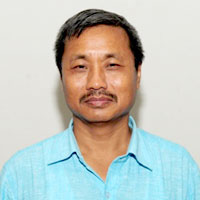Dr. Tapas Chakma M.B.B.S., M.A.E.
Scientist G
ICMR-National Institute of Research in Tribal Health
Profile
Dr. T. Chakma is an epidemiologist with experience on fluorosis and non-communicable diseases. He has contributed immensely to the national fluorosis control programme.
Research Interests
- Fluorosis
- Nutritional deficiency disorders and
- Hypertension
Scientific Staff
- Arvind Kavishwar, Principal Technical Officer
- Santosh K. Patkar, Technician - C
- Santosh K. Maravi , MTS
Past Research students
N/A
Ongoing research projects
- Health systems preparedness for interventions for non-communicable diseases and cause of death among the tribal population in India: ICMR Task Force Project (Division of NCD).
- Intervention Programme for the Management of Scabies - Baiga Tribe of Dindori district of Madhya Pradesh.
- Prevalence of Fluorosis in the Community of Selected Districts of India
- Development of an Appropriate Intervention Model For Prevention and Control of Fluorosis (Multi-Centric ICMR Taskforce Study).
Current research collaborators
N/A
Past research collaborators
N/A
Research in news
N/A
Award/Recognition/Honours
N/A
Workshop/Conference Organized
N/A
Academic contributions
N/A
Research Grants
N/A
Publications
- Kaur P,Kunwar A,Sharma M,Durgad K,Chakma T, et al(2022). The India Hypertension Control initiative early outcomes in 26 districts across five states of India, 2018-2020. Journal of Human Hypertension,https://www.nature.com/articles/s41371-022-00742-5
- Menon GR, Yadav J, Aggarwal S, Singh R, Kaur S, Chakma T, Periyasamy M, Venkateswaran C, Singh PK, Balachandar R, Kulkarni R, Grover A, Mishra BK, Viray M, Devi KR, Singh KHJ, Saha KB, Barde PV, Thomas B, Suresh C, A D, Watson B, Selvaraj P, Xavier G, John D, Menon J, Philip S, Mathew G, David A, Vaman RS,Et.al.(2022). Psychological Distress and Burnout among Healthcare Worker during COVID-19 Pandemic in India- A cross-sectional study. PLoS One,PMID: 35271652, PMCID: PMC8912126, DOI:10.1371/journal.pone.0264956,https://pubmed.ncbi.nlm.nih.gov/35271652/
- Chakma T,Shrivastava T and Kavishwar A (2022). Wrangle With Hypertension: Lowered Salt Intake May Not Compromise Iodine Status among Tribes of Central India. Cambridge University Press,Public Health Nutrition,DOI:https://doi.org/10.1017/S1368980022000131
- Chakma T, Beena E. Thomas,Kohli S,Moral R,Et.al(2021). Psychosocial impact of COVID -19 pandemic on Health Care Workers(HCWs) in India and their perceptions on the way forward- A qualitative study. Indian J Med Res,DOI:10.4103/ijmr.ijmr_2204_21,https://pubmed.ncbi.nlm.nih.gov/34596596/
- Mun A, Kumar R, Tiwari S, Uikey R, Thakur P, Mishra S, Chakma T, Shanmugam R(2021). First Observation of Compound Heterozygosity for Hb S/Hb Lepore-Hollandia in India. Indian J Hematol Blood Transfus,doi:10.1007/s12288-021-01475-0,https://www.ncbi.nlm.nih.gov/pmc/articles/PMC8315253/
- Shenoy P, Kohli GM, Kerketta A, Pathak P, Shetty S, Barde P,Chakma T (2021), Sen A. Clinical profile and response to steroids in post-fever retinitis: a nine-year experience from a referral institute in the rural hinterland of Central India. Int Ophthalmol,doi: 10.1007/s10792-021-01978-9,https://pubmed.ncbi.nlm.nih.gov/34297305/
- Shrivastava S, Chakma T, Das A, Verma AK (2021). Digitisation and realtime sharing of unified surveillance tool and clinicopathological data for efficient management of disease outbreaks. Int J Health Plann Manage,DOI:10.1002/hpm.3163,PMID:33797151,https://pubmed.ncbi.nlm.nih.gov/33797151/
- Kaur P,Kunwar A,Sharma M,Mitra J,Das C,Swasticharan L,Chakma T,Bangar SD,Venkatasamy V,Dharamsoth R,Purohit S,Tayade S,Singh GB,Bitragunta S,Durgad K,Das B,Dar S,Et.al.(2020). India Hypertension Control Initiative—Hypertension treatment and blood pressure control in a cohort in 24 sentinel site clinics, India. J Clin Hypertens,DOI: 10.1111/jch.14141,https://www.ncbi.nlm.nih.gov/pmc/articles/PMC8678731/
- Chakma T, Kavishwar A, Sharma RK, Rao PV (2017) High prevalence of hypertension and its selected risk factors among adult tribal population in Central India. Pathogens and Global Health,https://www.ncbi.nlm.nih.gov/pubmed/29139339
- Chakma T, Meshram P, Kavishwar A, Rao PV, Babu R (2014) Nutritional status of Baiga Tribe of Baihar, District Balaghat, Madhya Pradesh. Journal of Nutrition and Food Sciences,View
- Chakma T, Rao PV, Meshram P (2012) Factors associated with high compliance during Iron Folic Acid (IFA) supplementation in a tribal area of Madhya Pradesh, India. Public Health Nutrition,https://www.ncbi.nlm.nih.gov/pubmed/22640719
- Godfrey S, Labhasetwar P, Chakma T, Wate S, Swamy A, Bartram J (2011) Assessing and managing fluorosis risk in children and adults in rural Madhya Pradesh, India. Journal of water, sanitation, hygiene for development,View
- Chakma T, Godfrey S, Bhatt J, Rao PV, Meshram P, Singh SB (2008) Cross-sectional health indicator study of open defecation-free villages in Madhya Pradesh, India. Waterlines,http://www.jstor.org/stable/24685057
- Chakma TCo author (2007) a book titled “Integrated Fluorosis Mitigation: A guidance manual”. National Environmental Engineering Research Institute,View
- Dewan A, Bhatnagar VK, Mathur ML, Chakma T, Kashyap R, Harsiddha GS, Sinha SN, Saiyed HN (2004) Repeated episodes of endosulfan poisoning. Journal of Toxicology,Clinical Toxicology,https://www.ncbi.nlm.nih.gov/pubmed/15461244
- Chakma T, Rao PV, Singh SB, Tiwary RS (2000) Endemic Genu Valgum and Other Bone Deformities in Two Villages of Mandla District in Central India. Fluoride,http://www.fluorideresearch.org/334/files/FJ2000_v33_n4_p187-195.pdf
- Chakma T, Rao PV, Singh SB, Tiwary RS (1999) Health and Morbidity profile of Khairwar Tribe with Special Emphasis on Infertility. Indian Journal of Community Medicine,http://medind.nic.in/imvw/imvw6132.html
- Chakma T, Rao PV, Pall S, Kaushal LS, Dutta M, Tiwary RS (1996) Survey of Pulmonary Tuberculosis in a Primitive Tribe of Madhya Pradesh. Indian Journal of Tuberculosis,http://medind.nic.in/imvw/imvw11434.html


